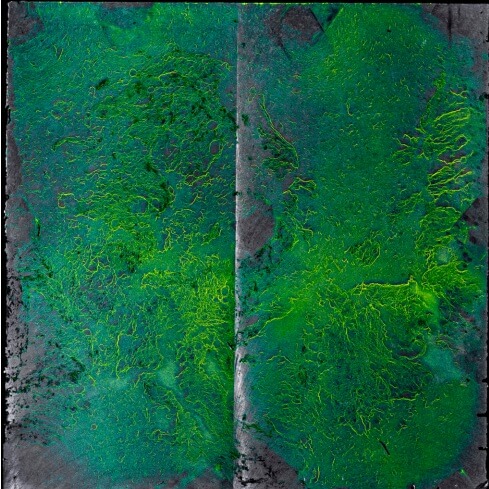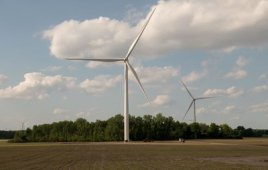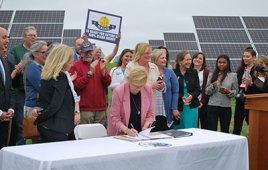Wind turbines rise into the sky on enormous towers. To ensure these giants reliably generate electricity for many years, the steel processing industry must manufacture its massive components in a stable, resource-saving and yet cost-effective way. However, material inclusions such as dross are often unavoidable in castings. Fraunhofer researchers are currently working to detect and analyze such material defects.

Dross in thick-walled cast iron with spheroidal graphite: casting surface after the fluorescent magnetic powder test. © Fraunhofer LBF | Picture in color and printing quality: www.fraunhofer.de/en/press
Wind turbines should be environmentally friendly, highly efficient, cost-effective, and able to function reliably for at least 20 years. However, as turbines become increasingly powerful, the demands on the components used also increase, and so is the risk of material fatigue. Material defects such as inclusions from slag, known as dross, are considered undesirable because they greatly reduce the load-bearing capacity of cast iron components with spheroidal graphite. This special kind of cast steel used to make a wind turbine’s mainframe and rotor hubs. Manufacturing such components is difficult due to the build-up of dross that often occurs despite tricks in casting techniques.
That is why foundries make sure they liberally remove all the dross and release only dross-free products for use. Since defects of this kind are usually found on the surface of the cast part or a few centimeters below the casting skin, the raw cast part is ground laboriously by hand. “Compared to other material defects, such as cavities in the component, there is as yet no way of reliably dealing with dross,” says Dr. Christoph Bleicher from the Fraunhofer Institute for Structural Durability and System Reliability LBF in Darmstadt. Since the beginning of 2015, he has been the consortium leader of the “unverDROSSen” project, which aims to move away from the customary requirements for dross-free products and thus dispense with the time-consuming post-production work.https://goo.gl/j05kXW
“To do this, we have to provide manufacturers and users with a sound measurement concept so they can evaluate the degree and type of dross. That’s why, together with the Fraunhofer Institute for Nondestructive Testing IZFP in Saarbrücken, we’re developing an experimentally proven dross strength classification system,” says Bleicher.
Minimizing rework
Fraunhofer experts have now succeeded in developing test methods with the aid of which they can detect, display and characterize dross. They use mechanized ultrasound testing to display and measure the distribution in a three-dimensional format. They also test processed component surfaces using magnetic and electromagnetic methods. With these methods, they scan not just the cast underside, as is customary, but also the dross-afflicted topside. “Using our nondestructive testing technology, we measured cuboids each measuring 500 x 500 x 200 mm. We found that the dross distribution in the test pieces varied extremely. Sometimes the material defect extends across a large surface area, and it can range in depth from a few millimeters to several centimeters,” reports Fabian Weber from Fraunhofer IZFP. “Results have not allowed us to derive any kind of regularity.” This means components will have to be examined individually in the future, too. However, with the valuable information that nondestructive IZFP test technologies provide, manufacturers can at least minimize necessary rework.
Classifying strength
In the second step of the project, Fraunhofer IZFP data will be used to assess structural durability. For this purpose, researchers from Fraunhofer LBF extract fatigue specimens, each measuring exactly 150 x 35mm from the delivered test pieces. “On the basis of static and cyclic test methods, we determine strength values for the different manifestations. To do this, we place the sample in one of our test benches, pull it and then press each sample back together up to ten million times. Such experiments run for about ten days,” explains Bleicher. A total of around 500 fatigue tests are planned during the three-year-long project.
By the end of 2017, the researchers want to find out if and to what extent dross-afflicted samples weaken when put under a load such that they might fail when at maximum load. It is a known fact that dross leads to crack formation, which greatly reduces the component’s cyclic load bearing capacity. “However, such cast-iron components are completely adequate for other purposes,” says Bleicher. “In the future, we will offer a concept for reliably handling material defects in component design, manufacture and release of large cast components made of cast iron with spheroidal graphite. This will apply not just to wind farms but to all plant and mechanical engineering sector,” concludes Bleicher with certainty.
Read more here: https://goo.gl/j05kXW
Filed Under: Uncategorized




